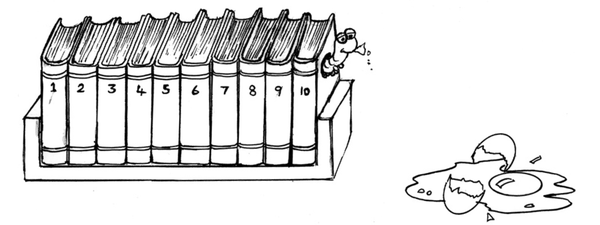| << Chapter < Page | Chapter >> Page > |
Let’s make funny riddles!
Match the questions and answers to make funny riddles:
1. C
2. F
3. A
4. H
5. I
6. J
7. E
8. D
9. B
10. G
Amazing mind ticklers
1 By dropping it from height of more than 90 cm (e.g. 1 metre); it will not break in the first 9 cm of its fall.

Three
Makes you think, doesn’t it? !
1. Strawberries
2. It must first be hoisted to the masthead and then lowered to half-mast.
Amazing creatures: Ants
Pugnacious ants
Like all ants, pugnacious ants are social insects and never live alone. The most important ant in the nest is the queen. She is large and fertile: she can lay eggs. The many other females are infertile workers that collect food, clean the nest, and look after the young ants. Male ants come near the nest for mating only.
Pugnacious ants often have large nests, sometimes with more than one queen. There are times when a queen and some workers will leave the nest and start a new one.
In the mating season the queen and the male ants grow wings and fly into the air. The queen mates with one or more of the few male ants. After the mating flight the queen’s wings fall off and the male ants die. The queen lays eggs in the nest, which hatch into larvae (worm-like creatures). The worker ants feed the larvae. Later the larvae change into pupae and then into adults.
If their nest is disturbed, pugnacious ants will defend it fiercely. They run around and attack anything near the nest. Their bite is painful to people. Pugnacious ants will eat almost anything, dead or alive. They eat many kinds of insects, especially termites, and are often found in old termite mounds.
They are even found on beaches where they look for bluebottles that have been washed up on the sand. These ants look for food during the day and will only go underground when it is very hot or wet. The workers are responsible for searching for food. When they find some, they send out a scent that tells the other workers about their discovery.
One way to tell them apart from other ants is that Pugnacious ants do not trail or run towards food in lines as other ants do.
People and anteaters are these ants’ worst enemies. The scaly anteater rips open ant nests with its strong claws and catches them with its long, sticky tongue. It helps to keep the ant population under control. Because ants come into our homes in search of food, man has developed poisons and various other methods of killing them.
Yet pugnacious ants are useful. They take fynbos seeds into their nests underground. At one end of these seeds is a covering that they eat. They then leave the seeds underground where germination can take place.

Notification Switch
Would you like to follow the 'English home language grade 6' conversation and receive update notifications?